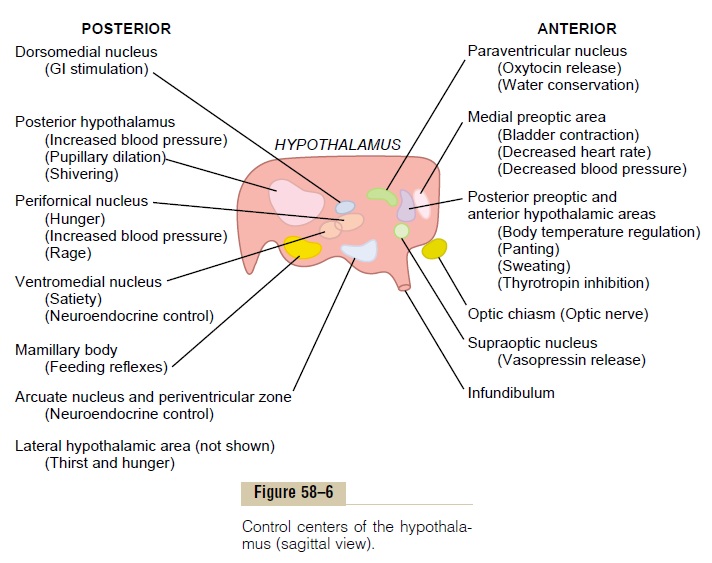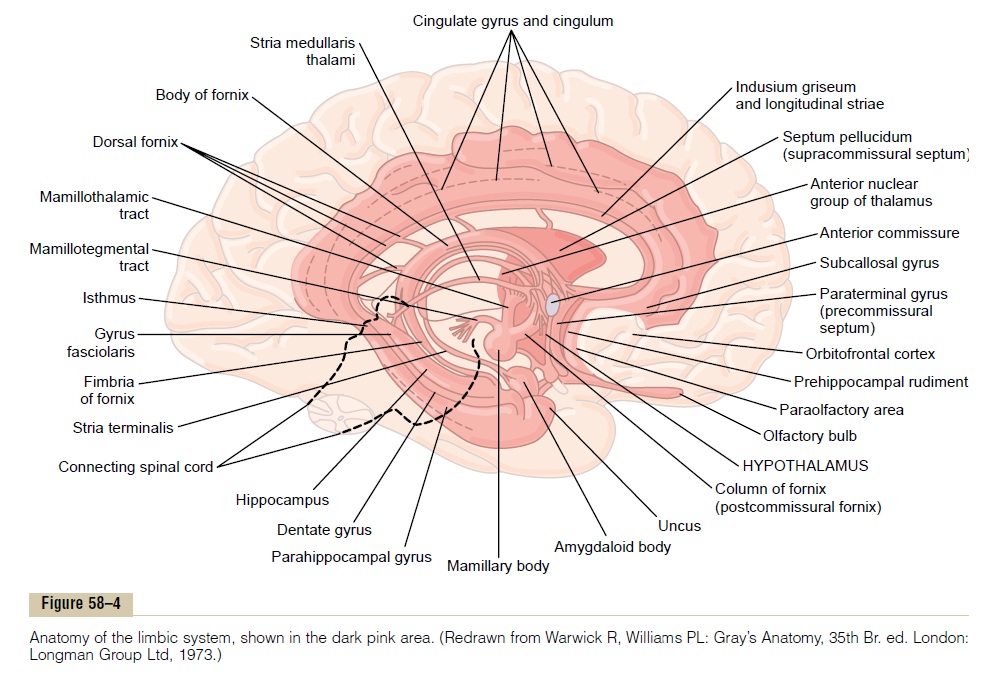Chapter: Medical Physiology: Behavioral and Motivational Mechanisms of the Brain-The Limbic System and the Hypothalamus
Vegetative and Endocrine Control Functions of the Hypothalamus
Vegetative and Endocrine Control Functions of the Hypothalamus
The different hypothalamic mechanisms for control-ling multiple functions of the body are so important. To illustrate the organization of the hypothalamus as a functional unit, let us summarize the more important of its vegetative and endocrine functions here as well.

Figures 58–6 and 58–7 show enlarged sagittal and coronal views of the hypothalamus, which represents only a small area in Figure 58–4. Take a few minutes to study these diagrams, especially to see in Figure 58–6 the multiple activities that are excited or inhib-ited when respective hypothalamic nuclei are stimu-lated. In addition to the centers shown in Figure 58–6, a large lateral hypothalamicarea (shown in Figure 58–7) is present on each side of the hypothalamus. The lateral areas are especially important in controlling thirst, hunger, and many of the emotional drives.


A word of caution must be issued for studying these diagrams because the areas that cause specific activi-ties are not nearly as accurately localized as suggested in the figures. Also, it is not known whether the effects noted in the figures result from stimulation of specific control nuclei or whether they result merely from activation of fiber tracts leading from or to control nuclei located elsewhere. With this caution in mind, we can give the following general description of the veg-etative and control functions of the hypothalamus.
Cardiovascular Regulation. Stimulation of different areasthroughout the hypothalamus can cause every known type of neurogenic effect on the cardiovascular system, including increased arterial pressure, decreased arterial pressure, increased heart rate, and decreased heart rate. In general, stimulation in the posterior and lateral hypo-thalamus increases the arterial pressure and heart rate,whereas stimulation in the preoptic area often has oppo-site effects, causing a decrease in both heart rate and arterial pressure. These effects are transmitted mainly through specific cardiovascular control centers in the reticular regions of the pons and medulla.
Regulation of Body Temperature. The anterior portion of thehypothalamus, especially the preoptic area, is concerned with regulation of body temperature. An increase in the temperature of the blood flowing through this area increases the activity of temperature-sensitive neurons, while a decrease in temperature decreases their activ-ity. In turn, these neurons control mechanisms for increasing or decreasing body temperature.
Regulation of Body Water. The hypothalamus regulatesbody water in two ways: (1) by creating the sensation of thirst, which makes the animal or person drink water, and (2) by controlling the excretion of water into the urine. An area called the thirst center is located in the lateral hypothalamus. When the fluid electrolytes in either this center or closely allied areas become too concentrated, the animal develops an intense desire to drink water; it will search out the nearest source of water and drink enough to return the electrolyte con-centration of the thirst center to normal.
Control of renal excretion of water is vested mainly in the supraoptic nuclei. When the body fluids become too concentrated, the neurons of these areas become stimulated. Nerve fibers from these neurons project downward through the infundibulum of the hypothala-mus into the posterior pituitary gland, where the nerve endings secrete the hormone antidiuretic hormone (also calledvasopressin). This hormone is then absorbed into the blood and transported to the kidneys where it acts on the collecting ducts of the kidneys to cause increased reabsorption of water. This decreases loss of water into the urine but allows continuing excretion of electrolytes, thus decreasing the concentration of the body fluids back toward normal.
Regulation of Uterine Contractility and of Milk Ejection from the Breasts. Stimulation of theparaventricular nucleicausestheir neuronal cells to secrete the hormone oxytocin. This in turn causes increased contractility of the uterus as well as contraction of the myoepithelial cells sur-rounding the alveoli of the breasts, which then causes the alveoli to empty their milk through the nipples.
At the end of pregnancy, especially large quantities of oxytocin are secreted, and this secretion helps to promote labor contractions that expel the baby. Then, whenever the baby suckles the mother’s breast, a reflex signal from the nipple to the posterior hypothalamus also causes oxytocin release, and the oxytocin now per-forms the necessary function of contracting the ductules of the breast, thereby expelling milk through the nipples so that the baby can nourish itself.
Gastrointestinal and Feeding Regulation. Stimulation ofseveral areas of the hypothalamus causes an animal to experience extreme hunger, a voracious appetite, and an intense desire to search for food. One area associated with hunger is the lateral hypothalamic area. Con-versely, damage to this area on both sides of the hypo-thalamus causes the animal to lose desire for food, sometimes causing lethal starvation.
A center that opposes the desire for food, called the satiety center, is located in the ventromedial nuclei. When this center is stimulated electrically, an animal that is eating food suddenly stops eating and shows complete indifference to food. However, if this area is destroyed bilaterally, the animal cannot be satiated; instead, its hypothalamic hunger centers become overactive, so that it has a voracious appetite, resulting eventually in tremendous obesity. Another area of the hypothalamus that enters into overall control of gas-trointestinal activity is the mamillary bodies; these control at least partially the patterns of many feeding reflexes, such as licking the lips and swallowing.
Hypothalamic Control of Endocrine Hormone Secretion by the Anterior Pituitary Gland. Stimulation of certain areas of thehypothalamus also causes the anterior pituitary gland to secrete its endocrine hormones. This subject is discussed in detail in relation to neural control of the endocrine glands. Briefly, the basic mechanisms are the following.
The anterior pituitary gland receives its blood supply mainly from blood that flows first through the lower part of the hypothalamus and then through the anterior pituitary vascular sinuses. As the blood courses through the hypothalamus before reaching the anterior pitu-itary, specific releasing and inhibitory hormones are secreted into the blood by various hypothalamic nuclei. These hormones are then transported via the blood to the anterior pituitary gland, where they act on the glandular cells to control release of specific anterior pituitary hormones.
Summary. A number of areas of the hypothalamuscontrol specific vegetative and endocrine functions. These areas are still poorly delimited, so much so that the specification given above of different areas for dif-ferent hypothalamic functions is partially tentative.
Related Topics